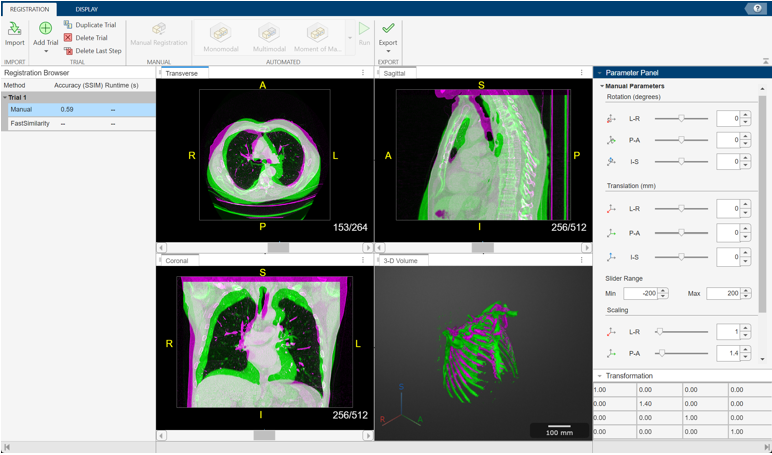Medical Image Registration
Medical image registration is the process of aligning multiple medical images, volumes, or surfaces to a common coordinate system. In medical imaging, you may need to compare scans of multiple patients or scans of the same patient taken in different sessions under different conditions. Use medical image registration as a preprocessing step to align the medical images to a common coordinate system before you analyze them.
Scenarios for Medical Image Registration
Classification by Type of Misalignment
Translation registration - Required when the two images, volumes, or surfaces differ by a global shift common to all pixels, voxels, or points.

Rigid registration - Required when the two images, volumes, or surfaces differ by a global shift and a global rotation common to all pixels, voxels, or points.

Similarity registration - Required when the two images, volumes, or surfaces differ by a global shift, a global rotation, and a global scale factor common to all pixels, voxels, or points.

Affine registration - Required when the two images, volumes, or surfaces differ by a global shift, a global rotation, a global scale factor, and a global shear factor common to all pixels, voxels, or points.

Deformable registration (also known as non-rigid registration) - Required when the images, volumes, or surfaces differ by local transformations specific to certain pixels, voxels, or points.

Classification by Type of Input
Image registration - Aligns 2-D grayscale images.
Volume registration - Aligns 3-D intensity volumes.
Surface registration - Aligns surfaces extracted from 3-D intensity volumes.
Groupwise registration - Aligns slices in a series of 2-D medical images, such as a timeseries, to reduce sliding motion between the slices.
Interactive Registration Using Apps
The Medical Registration Estimator app (since R2024b) enables you to interactively register 3-D medical image volumes. You can manually translate, rotate, and scale the volumes to align them, or apply automated rigid and deformable registration techniques. You can compare different techniques, tune settings, and visualize the registered volumes as 2-D slice planes and 3-D volumes. The app provides a quantitative measure of registration accuracy, and you can export the registered volume and the transformation matrix. The app can also generate code with your selected registration technique to apply to other volumes outside of the app. To learn more, see Get Started with Medical Registration Estimator.

To register 2-D images, use the Registration Estimator app.
Functions for Medical Image Registration
Medical Imaging Toolbox™ provides various functions for medical image registration.
| Function | Type of Misalignment | Type of Input | Function Details | Method |
|---|---|---|---|---|
imregmoment | Translation Rigid Similarity | 2-D grayscale images 3-D intensity volumes | Returns registered image and transform. | Fast registration technique. Uses moment of mass method, with the option to also use the median threshold bitmap (MTB) method. Suitable for monomodal and multimodal images and volumes. |
imregister | Translation Rigid Similarity Affine | 2-D grayscale images 3-D intensity volumes | Specify configuration using Returns registered image. Get transform by using | Optimization-based technique. Regular step gradient descent optimizer with mean squares metric for monomodal configuration. One-plus-one evolutionary optimizer with Mattes mutual information metric for multimodal configuration. |
imregcorr | Translation Rigid Similarity | 2-D grayscale, binary, and RGB images | Returns transform. Get the registered image by using imwarp. | FFT-based technique. Uses the phase correlation method. |
imregmtb | Translation | 2-D grayscale and RGB images | Returns registered images and displacement vector. | Fast registration technique. Uses median threshold bitmap (MTB) method. Suitable for monomodal and multimodal images. |
imregicp | Translation Rigid | Surfaces | Returns registered surface and transform. | Optimization-based technique. Uses the iterative closest point (ICP) algorithm. |
imregdemons | Deformable | 2-D grayscale images 3-D intensity volumes | Returns registered image and displacement field. | Deformable registration technique. Uses a diffusion-based Demons algorithm. |
imregdeform | Deformable | 2-D grayscale images 3-D intensity volumes | Returns registered image and displacement field. | Deformable registration technique. Uses the isotropic total variation regularization method. |
imreggroupwise | Deformable | 3-D image series consisting of 2-D slices | Returns registered image and displacement field. Requires only one input image. | Groupwise registration technique. Uses the isotropic total variation regularization method. |
fitgeotform2d | Similarity Reflective Similarity Affine | 2-D control point pairs | Returns transform. Get the registered image by using imwarp. | Performs 2-D point mapping between pairs of control points. |
fitgeotform3d | Translation Rigid Affine | 3-D control point pairs | Returns transform. Get the registered image by using imwarp. | Performs 3-D point mapping between pairs of control points. |
See Also
Apps
Functions
imregister|imregtform|imregconfig|imregicp|imregmtb|imregmoment|imregdemons|imregdeform|imreggroupwise|imregcorr|imwarp|fitgeotform2d|fitgeotform3d
Topics
- Get Started with Medical Registration Estimator
- Rigid Registration Using Medical Registration Estimator App
- Deformable Registration Using Medical Registration Estimator App
- Register Multimodal Medical Image Volumes with Spatial Referencing
- Register 3-D Multimodal Medical Image Volumes Using Anatomical Landmarks